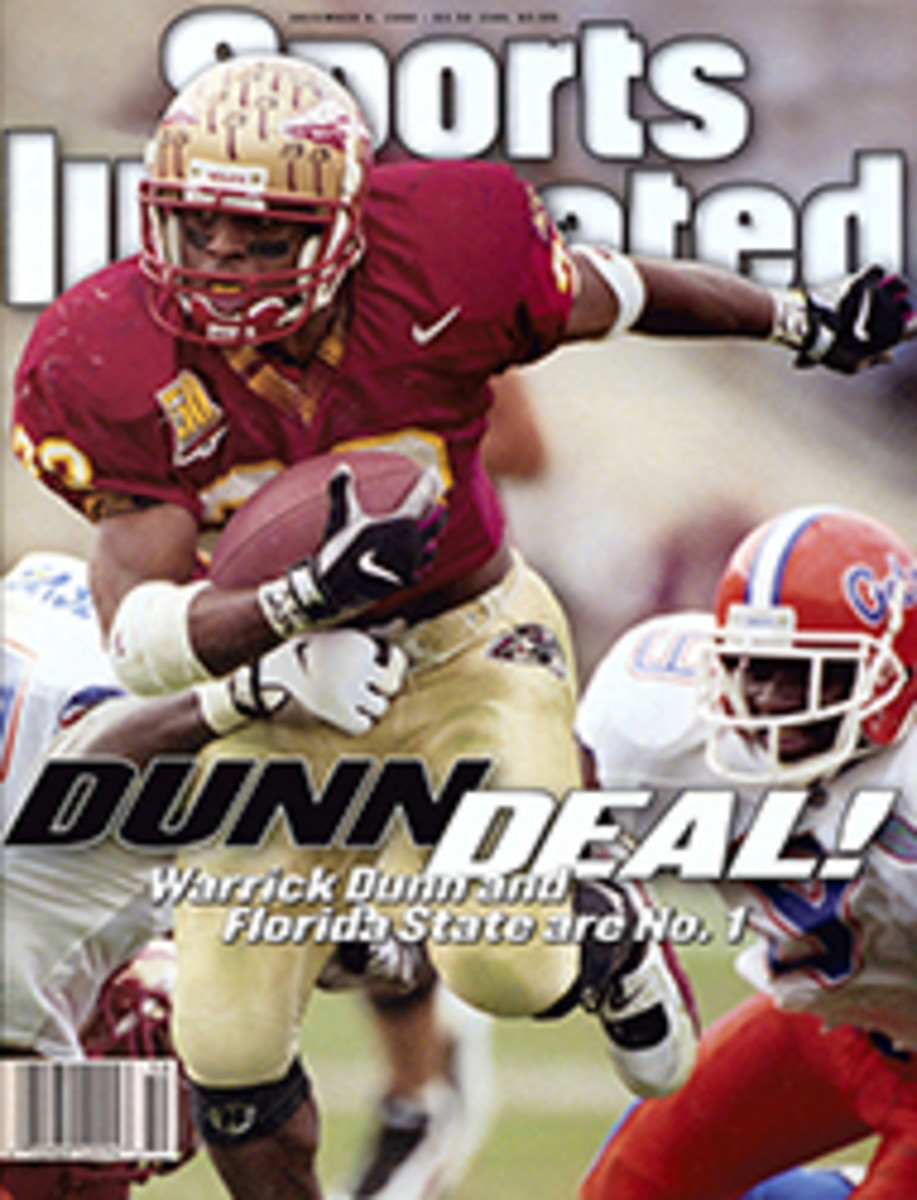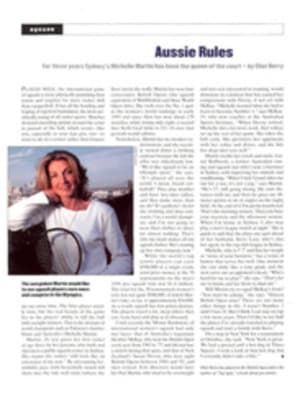
A HARD DAY'S NIGHT THE GRUELING 24 HOURS OF ASPEN IS DOWNHILL RACING AT ITS LONGEST AND MOST INSANE
"I'm not looking forward to this," said British ski racer
Malcolm Erskine, standing atop Aspen Mountain just before noon
on Dec. 11, 1995. "I never look forward to this--it's nothing
but pain and misery and the worst backache you can ever imagine.
I just wish I weren't so addicted to it."
With the demeanor of a man heading to the gallows, Erskine
walked over to the start area to join his teammate, fellow
British racer and three-time Olympian Martin Bell. "Let's hope
we don't push each other out of the gondola in the middle of the
night," quipped Bell. Erskine shot him a sarcastic grin. The
pair clicked into their skis, snapped on their helmets and,
buoyed by the crowd, pushed off to begin the Land Rover 24
Hours of Aspen--the longest, most illogical ski race in the world.
Each year, the 24 Hours of Aspen transforms a sport based on
speed and individual performance into one based on endurance and
intense teamwork. The contest rules are exceedingly simple (and,
as more than one competitor has noted, insane): Two-person teams
must ski, together, down Aspen's World Cup-style downhill course
as many times as possible in one 24-hour span. They can rest
only during the 14-minute gondola ride from the bottom to the
top. The team completing the most runs wins. Wins what? Nothing
but the race's attendant glory. All proceeds from the 24 Hours
go to charity.
The 24 Hours, it should come as no surprise, was the brainchild
of a person well acquainted with pain. Twelve years ago, an
Aspen ski bum named Ed McCaffrey crashed while competing in a
recreational downhill race, shredding his left knee so badly
that surgeons considered amputating his lower leg. During
McCaffrey's three-month hospital stay, he thought constantly
about skiing, about suffering, about the limits of human
endurance and about his father, John, who has multiple sclerosis.
When Ed left the hospital, he combined these seemingly disparate
notions and came up with a plan for the first 24 Hours ski race.
Three years later, in December 1987, the race was held.
McCaffrey and his partner topped four other teams, established a
world record for most vertical feet skied in one day and raised
$10,000 for the Jimmy Heuga Center, which aids people with MS in
Vail, Colo.
The competition caused a sensation. The next year eight teams
from around the globe entered the Aspen event, and a Swiss pair
won the race and set another record. "You push yourself so far
out there that you reach this trancelike state of blissful
exhaustion," says McCaffrey, 38, attempting to explain the
race's popularity. "It's truly amazing--it keeps people coming
back every winter."
This year's 24 Hours will be held on Dec. 14 and 15 and is
expected to draw nine men's teams and one women's team. It is
now viewed as skiing's version of the Ironman: Winners are
regarded as the world's strongest and least sensible skiers.
Such a designation is bound to attract some odd personalities,
as last December's race did. The field for the 1995 event
included 20 racers from seven countries (eight men's teams, two
women's), virtually all of them 24 Hours veterans.
Five teams were considered favorites. There were the Germans:
Martin Fiala, 27, and his partner Michael Veith, 38 (the event's
oldest competitor), both built like tanks and hoping to muscle
their way through the race. There were the Americans: defending
champions Nate Bryan, 25, and Tyler Williams, 25, both built
more like twigs and relying on style and finesse. There were the
Swiss: Andre Kindschi and Roger Sieber, a pair of 23-year-olds
who work as lumberjacks in the off-season and whose irresistible
cuteness garnered them a Beatlesque following of cheering women.
There were the Austrians: earringed and ponytailed bad boys Axel
Naglich and Chris Reindl, both 27, who prepared for the race,
according to Naglich, by "staying up late--every weekend."
Finally there were the Brits: Erskine, 31, and Bell, 30, who
with their Abbott-and-Costello routine about their lack of
fitness evidently hoped to kvetch themselves to victory.
The women's competition was between two U.S. teams: the
gregarious Harvey twins, Katie and Megan, 26, and the intense
Aspenites, reigning champs Kate McBride, 29, and Gella Sutro, 30.
The race course plunges 3,267 vertical feet down Aspen Mountain
and includes a half dozen ski-jump-style airs; a steep, straight
section called Spar Gulch; and the treacherous Kleenex Corner, a
narrow hairpin turn hugging a granite wall. At noon the teams
started at 75-second intervals. All the competitors skated
furiously across the top flats before dropping into tight tucks.
The course was glazed with ice. The racers sped down Spar,
accelerating to more than 90 mph and creating a noise like that
of incoming missiles as they flew by. Behind each racer trailed
a stream of ice crystals suspended in the air like jet contrails.
During the run each skier tried to remain as close to his or her
teammate as possible, so that the pair could derive the greatest
benefit from drafting. Some teams elected to alternate the skier
in front from run to run, some remained in the same positions
for the whole race, but the fastest--and most daring--strategy
was the slingshot technique, in which the skiers would change
position two or three times during a run, often passing one
another while in the air or rounding a bend. "Skiing so close
together at high speed is amazingly dangerous," said Bell, a
15-year veteran of the British national team. "Every time you
see your partner in front of you make a tiny twitch or bobble,
you think, Which way will I go when he crashes? It's nerve-
racking. And when it gets dark and you can't see as well, the
danger is doubled."
At the end of each run the competitors, legs burning from the 2
1/2-minute descent, came tearing into the base area, where a
team of "catchers" was positioned to stop them from slamming
into the gondola building. The teammates burst out of their skis
and dived for the nearest gondola, while a swarm of attendants
provided them with blankets, heat packs, energy drinks, pasta,
vitamins and brief massages. The all-too-brief gondola ride back
up offered a chance for the skiers to rest, stretch, eat,
strategize and, if necessary, use the bathroom--a bucket
half-filled with Kitty Litter.
At the top they leaped out of the egg-shaped gondolas, jumped
into their skis and started the whole process again. "I feel
like Bill Murray in Groundhog Day," said Canadian racer Ian
Sullivan at 2 a.m. while riding up to make his 42nd lap. "Every
time the gondola doors open up, it's like, Oh, no, here I am
again."
The first three hours of the race produced two brutal crashes,
both at Kleenex Corner, both by Americans--Jeff Hamilton, from a
team of Olympic speed skiers, injured his back, and Megan Harvey
sprained her neck. Night came quickly (in December it is dark 14
hours a day in Aspen), and the course lights were switched on.
The long night took its toll: A tumble forced the German team to
quit, and the remaining competitors became less and less lucid.
The women's team of McBride and Sutro, reduced to eating nothing
but Tums, would collapse into deep sleep for the entire gondola
ride. "Depression has set in," Erskine reported just before
dawn. "I think we're all feeling it."
Everyone but the Austrians. In their fourth year as 24 Hours
teammates, Naglich and Reindl dominated the competition, holding
tighter tucks, skiing closer together, and repeatedly having the
fastest lap times. "I'm not feeling any pain," claimed Naglich
as the end neared. "Really--nothing at all. If you paid me a
million dollars, I'd ski another 24 hours."
Said teammate Reindl: "Make that two million."
In the end the Austrians weren't paid a dime, but they did ski
212.51 total miles, shy of the world record of 223.27 set in
1991 by Canada's Chris Kent and well ahead of the second-place
U.S. team of Bryan and Williams. McBride and Sutro finished
fifth overall on their way to a second women's title. "We
trained all summer, every day, specifically for the 24 Hours,"
said Naglich, standing on the victory podium and swigging from a
champagne bottle. Then he winked to the crowd and pointed at his
partner. "I don't plan to talk to Chris for the next six months.
I'm tired of being with him."
Michael Finkel, of Bozeman, Mont., pulled an all-nighter to
cover the 24 Hours of Aspen.
COLOR PHOTO: PHOTOGRAPHS BY CARL YARBROUGH Staying the course in the pitch darkness, skiing pairs flew down Aspen Mountain again and again. [Two skiers on mountain]
COLOR PHOTO: PHOTOGRAPHS BY CARL YARBROUGH After resting on the gondola ride up, the Swiss duo of Sieber (left) and Kindschi rushed to another run. [Roger Sieber and Andre Kindschi exiting gondola]

